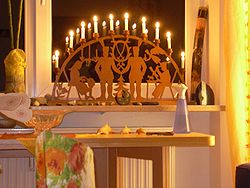- Schwibbogen
-
A Schwibbogen is a decorative candle-holder from the Ore Mountains (Erzgebirge) region of Saxony, Germany.
The first metal Schwibbogen was made in 1740 in Johanngeorgenstadt. The early candle arches always consisted of black ore. They were made out of one single forged piece and could be painted. The number of candles varies with the size of the arc. The original one featured 11.
The most famous design was created by Paula Jordan in 1937 for a show in Schwarzenberg. It depicted the 3 main sources of income of the people in the region in the 18th and 19th century. Thus the Schwibbogen showed apart from some traditional symbols; 2 miners, 1 wood carver, a bobbin lace maker, a Christmas Tree, 2 miner's hammers, 2 crossed swords, and an angel. It holds 7 candles. Contrary to popular belief the candle holder was always associated with Christmas. The light symbolizes the longing of the miners who didn't see the daylight in winter for weeks sometimes due to their long working hours below the surface. Over time the designs changed. Especially in the last few decades after the World War II the Schwibbogen has reached not only a new popularity, but has changed a lot in its looks. Now it is typically made out of wood which depicts historical or religious scenes. But there are even landscapes, skylines, advertisements ... there is almost no limit to the possibilities. What remains is the link to Christmas traditions. Especially in the Ore Mountains the windows of the houses in villages and towns feature a lit candle arch - usually with the traditional designs or at least local scenes.
The town of Seiffen is particularly noted for its production of Schwibbogen in its craft shops.
See also
- Wooden toymaking in the Ore Mountains
External links

This Ore Mountains article is a stub. You can help Wikipedia by expanding it.

